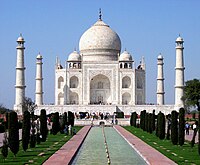| Aram Bagh, Agra (Ram Bagh) | |
|---|---|
 A Chhatri at Aram Bagh, in 2024 A Chhatri at Aram Bagh, in 2024 | |
| Type | Botanical garden |
| Location | Agra, India |
| Coordinates | 27°12′20.347″N 78°2′15.9″E / 27.20565194°N 78.037750°E / 27.20565194; 78.037750 (Aram Bagh, Agra) |
| Established | 1526; 498 years ago (1526) |
| Founder | Babur |
| Status | Open all year |
| Monument of National Importance | |


The Aram Bagh (also known as Ram Bagh) is the oldest Mughal Garden in India, originally built by Emperor Babur, the first Mughal Emperor, in 1526, located about five kilometers northeast of the Taj Mahal in Agra, India. Babur was temporarily buried there before being interred in Kabul.
Etymology
The name Aaram Bagh translates to 'Garden of Rest'.
When Emperor Babur laid out this garden, he named it ‘Bāgh-i-Gul Afshān’ (lit. 'The Flower-Scatterer Garden'). It was later renamed as Aram Bagh or the ‘Garden of Rest’. When the Marathas came to power in Agra between 1774 to 1803, they changed the name from ‘Aram Bagh’ to ‘Ram Bagh’, and the name has remained ever since.
It is also variously known as 'Bagh-i Nur Afshan' which translates to 'Light-Scattering Garden', Aalsi Bagh or 'Lazy Garden': according to legend, Emperor Akbar proposed to his third wife, who was a gardener there, by lying idle for six days until she agreed to marry him.
History
The garden is a Persian garden, where pathways and canals divide the garden to represent the Islamic ideal of paradise, an abundant garden through which rivers flow. The Aram Bagh provides an example of a variant of the charbagh in which water cascades down three terraces in a sequence of cascades. Two viewing pavilions face the Jumna river and incorporates a subterranean 'tahkhana' which was used during the hot summers to provide relief for visitors. The garden has numerous water courses and fountains.
Jahangir waited in the garden in early March 1621 for the most astrologically auspicious hour for him to enter Agra after he took the Fort of Kangra. Jahangir made several additions in the garden, which includes two marble pavilions and a number of chhatris. The preserved, surviving architecture dates to his reign and demonstrates the skill of his wife Nur Jahan as a garden designer.
In art and literature
An engraving of Thomas Shotter Boys' painting is in Fisher's Drawing Room Scrap Book, 1835, together with a poetical illustration (The history of Shah Dara's flight and death) by Letitia Elizabeth Landon entitled ![]() Jahara Baug, Agra.
Jahara Baug, Agra.
Citations
- ^ Datta, Rangan (5 July 2024). "Agra beyond the Taj: Exploring tombs and gardens on the left bank of Yamuna". The Telegraph. My Kolkata. Retrieved 18 July 2024.
- ^ Nath 1982, p. 91.
- Chaturvedi, Hemendra (21 January 2024). "Today's Ram Bagh was once 'Aram Bagh' of Mughal emperor Babur". Hindustan Times. Archived from the original on 10 September 2024. Retrieved 10 September 2024.
- ^ Koch, p.37-41
- Landon, Letitia Elizabeth (1834). "poetical illustration and picture". Fisher's Drawing Room Scrap Book, 1835. Fisher, Son & Co.
References
- Koch, Ebba (20 August 2023). The Complete Taj Mahal: And the Riverfront Gardens of Agra (Hardback) (First ed.). Thames & Hudson Ltd. pp. 288 pages. ISBN 978-0-500-34209-1.
- Turner, Tom (1998). "Gardens guide - Aram Bagh". Gardenvisit.com. Archived from the original on 16 October 2006. Retrieved 14 March 2007.
- "Arambagh Gardens Agra". Agra hub. Archived from the original on 6 April 2007. Retrieved 14 March 2007.
- Nath, Ram (1982), History Of Mughal Architecture Vol.1, Abhinav Publications, ISBN 9788170171591
Further reading
- Petruccioli, Attilio (ed.); Koch, Ebba (1997). "The Mughal Waterfront Garden. In Gardens in the Time of the Great Muslim Empires: Theory and Design". E. J. Brill. Retrieved 13 February 2007.
{{cite web}}:|author=has generic name (help)
External links
| Tourist attractions in and near Agra | ||
|---|---|---|
| World Heritage Sites |  | |
| Mughal architecture | ||
| Mosques | ||
| Other religious places | ||
| Shopping | ||
| Gardens | ||
| Wildlife sanctuaries | ||
| Fairs | ||
| Agra division topics | |||||
|---|---|---|---|---|---|
| General | |||||
| Mythology, history |
| ||||
| Places of tourist interest |
| ||||
| Districts | |||||
| Rivers, dams, lakes, canals | |||||
| Languages, people | |||||
| Transport | |||||
| Lok Sabha constituencies | |||||
| See also |
| ||||
| Other divisions | |||||